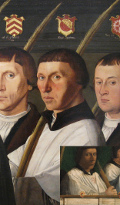Portraits of Jerusalem pilgrims: a Dutch phenomenon?
The great majority of the portraits included here come from the Netherlands. Are portraits of Jerusalem pilgrims a typically Netherlandish phenomenon? Such a question is always difficult to answer based on quantity alone, since it is unknown how many have been lost over time. Moreover, systematic research into the non-Netherlandish portraits is lacking, which might present a distorted image.
What is striking is the regional variety. The palm branch as a symbol for a Jerusalem pilgrimage is not known from German-speaking areas, for instance. Its use seems to be closely connected to the presence of confraternities of Jerusalem pilgrims. And indeed it is striking that the use of palm branches as attribute lives on in seventeenth-century Antwerp, where the confraternity was revived. At the very least one can state that the Jerusalem confraternities were a phenomenon of the Low countries, with its own characteristic memorial culture.
Moreover, there seems to be a strong personal influence in the development of the theme of certain artists: Jan van Scorel was responsible for the majority of the confraternity portraits, and included his own depiction in them (Louise van Tongerloo even suspects that it was Van Scorel who took the initiative to create the confraternity portraits1). Also, his name has been connected to a number of single portraits. Moreover, the single portraits before 1525 were remarkably often connected to the Master of Alkmaar, who probably moved in the same social and professional circles for a time as Van Scorel. And Antonie Mor, pupil of Van Scorel, was responsible for some of the portraits as well.
In any case, the German portraits of Jerusalem pilgrims have an entirely different character than those from the Netherlands. Further research may reveal the existence of more portraits from outside the Netherlands, which could completely turn the idea of Jerusalem pilgrims' portraits as a 'Dutch phenomenon' on its head. On the other hand, it is also very well possible that outside the Netherlands other commemorative practices were more common than the creation of a portrait as a Jerusalem pilgrim. One might think of tomb monuments or travel reports, for example.
Previous: Attributes and insignia
Next: Overview of the objects
- Tongerloo, Louise van, 'Grablegung und Totengedenken bei Pilgerbruderschaften in Utrecht, mit einer Neuinterpretation von Scorels und Mors Bildnisreihen von Jerusalemfahrern,' in Truus van Bueren and Andrea van Leerdam, Care for the Here and Hereafter: Memoria, Art and Ritual in the Middle Ages (Turnhout 2005), pp. 221-247, p. 233.


